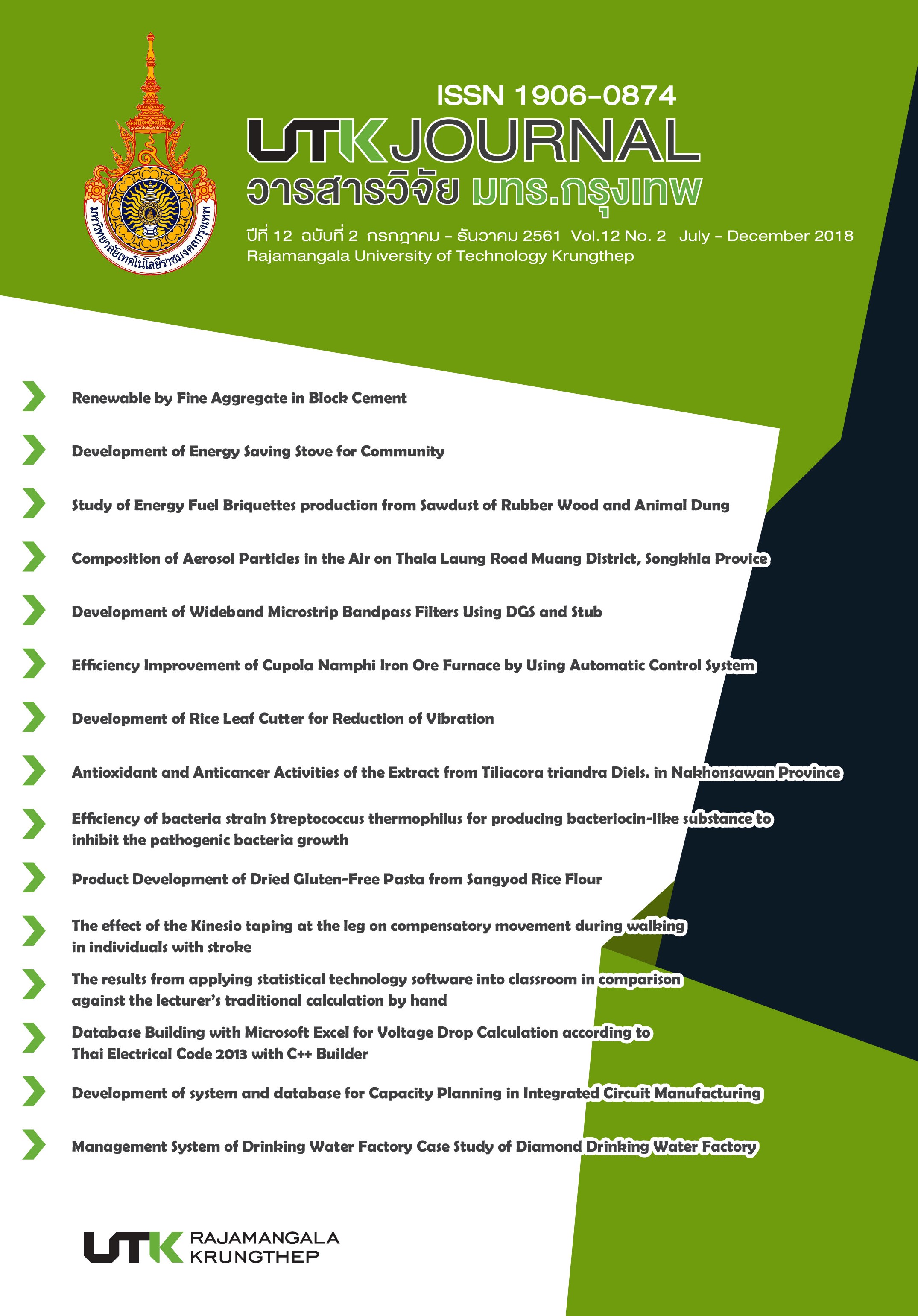The effect of the Kinesio taping at the leg on compensatory movement during walking in individuals with stroke
Keywords:
Stroke, Gait, Compensatory movement, Kinesio tapingAbstract
In walking of individuals with stroke, they usually present compensatory movement of the hip, knee, and ankle, instead of having normal movement. These problems may reduce the ability of daily living activities and increase the risk of fall. Therefore, present study aimed to investigate the effect of the Kinesio taping at the leg on compensatory movement during walking in individuals with stroke. Fourteen individuals with stroke participated in the study, classified into 11 males and 3 females. Their mean age was 57.42 ± 12.25 years and mean onset was 9.00 ± 5.57 months. Participants were assessed gait performance by using 3D motion analysis system at pre- and post-taping. Techniques of taping included 1) functional correction technique for the ankle dorsiflexion and pronation 2) inhibition technique at the ankle plantarflexors muscle. Averaged data from 3 gait trials were used in the analysis. The results showed significant improvement (p < 0.05) of gait speed, affected step length, single support time, and the ankle dorsiflexion after applying kinesio taping. In conclusion, the Kinesio taping may improve some gait performance but may not enough to reduce gait compensation significantly. Hence, a larger number of participants and long-term study is needed to investigate the effect of KT.
References
[2] Balaban B., Tok F. Gait disturbances in patients with stroke. PM&R. 2014; 6(7):635-42.
[3] Yavuzer MG. Walking After Stroke: Interventions to restore normal gait pattern: Erasmus University Rotterdam; 2006.
[4] Murray E. Stroke rehablitation. Baltimore: Williams & Wilkins; 1987.
[5] Takeuchi N., Izumi S. Maladaptive plasticity for motor recovery after stroke: mechanisms and approaches. Neural plast [internet]. 2012 [cited 2018 oct 20]; 359728-9. Available from: https://www.ncbi.nlm.nih.gov/pubmed/22792492
[6] Bae YH., Kim HG., Min KS., et al. Effects of lower leg kinesiology taping on balance ability in stroke patients with foot drop. Evid Comple Altern Med [internet]. 2015 [cited 2018 oct 20]; 125629-5. Available from https://www.ncbi.nlm.nih.gov /pmc/articles/PMC4633546/
[7] Belda-Lois JM., Mena-del Horno S., Bermejo-Bosch I., et al. Rehabilitation of gait after stroke: a review towards a top-down approach. J Neuroeng Rehabil. 2011; 8:66.
[8] Kase K., Wallis J., and Kase T. Clinical therapeutic applications of the kinesio taping method. 2ndedition. Tokyo, Japan: Ken Ikai Co. Ltd.; 2003.
[9] Morris D., Jones D., Ryan H., et al. The clinical effects of Kinesio(R) Tex taping: A systematic review. Physiother Theory Pract. 2013; 29(4):259-70.
[10] Choi Y-K., Park Y-H., Lee J-H. Effects of Kinesio taping and Mcconnell taping on balance and walking speed of hemiplegia patients. J Phys Ther Sci. 2016; 28(4):1166-9.
[11] Kim WI., Park YH., Sung YB., et al. Effects of kinesio taping for ankle joint and ankle-foot orthosis on muscle stimulation and gait ability in patients with stroke suffering foot drop. Adv Sci Technol 2015; 116:261-265.
[12] Park SJ. The immediate effects of proprioceptive neuromuscular facilitation with taping on gait parameters in patients with chronic stroke. J Phys Ther Sci. 2017; 29(11):2018-21.
[13] Rojhani SZ., Amirian S., Meftahi N. Effects of Ankle Kinesio Taping on Postural Control in Stroke Patients. J Stroke Cerebrovasc Dis. 2015; 24(11):2565-71.
[14] Magalhães HCdG., Menezes KKPd., Avelino PR. Efeitos do uso do Kinesio® Taping na marcha de indivíduos pós-acidente vascular encefálico: uma revisão sistemática com metanálise. Fisioterapia e Pesquisa. 2017; 24:218-28.
[15] Callaghan MJ., Selfe J., Bagley PJ., et al. The Effects of Patellar Taping on Knee Joint Proprioception. J Athl Train. 2002; 37(1):19-24.
[16] Allah Rastil Z., Shamsoddini A., Dalvand H., et al. The Effect of Kinesio Taping on Handgrip and Active Range of Motion of Hand in Children with Cerebral Palsy. Iran J Child Neurol. 2017; 11(4):43-51.
[17] Kim WI, Choi YK, Lee JH, et al. The effect of muscle facilitation using kinesio taping on walking and balance of stroke patients. J Phys Ther Sci. 2014; 26(11):1831-4.
[18] Stanhope VA, Knarr BA, Reisman DS, et al. Frontal plane compensatory strategies associated with self-selected walking speed in individuals post-stroke. Clinical biomechanics (Bristol, Avon). 2014; 29(5):518-22.
[19] Zollo L, Zaccheddu N, Ciancio AL, et al. Comparative analysis and quantitative evaluation of ankle-foot orthoses for foot drop in chronic hemiparetic patients. Eur J Phys Rehabil Med. 2015; 51(2):185-9
Downloads
Published
How to Cite
Issue
Section
License
กองบรรณาธิการวารสารวิชาการ มหาวิทยาลัยเทคโนโลยีราชมงคลกรุงเทพ มีความยินดีที่จะรับบทความจากอาจารย์ นักวิจัย นักวิชาการทั้งภายในและภายนอกมหาวิทยาลัย ในสาขาวิชาวิทยาศาสตร์และเทคโนโลยี ได้แก่ สาขาวิชาวิทยาศาสตร์ วิศวกรรมศาสตร์ และสาขาอื่นๆ ที่เกี่ยวข้อง รวมถึงสาขาต่างๆ ที่มีการบูรณาการข้ามศาสตร์ที่เกี่ยวข้องวิทยาศาสตร์และเทคโนโลยี ที่เขียนเป็นภาษาไทยหรือภาษาอังกฤษ ซึ่งผลงานวิชาการที่ส่งมาขอตีพิมพ์ต้องไม่เคยเผยแพร่ในสิ่งพิมพ์อื่นใดมาก่อน และต้องไม่อยู่ในระหว่างการพิจารณาของวารสารอื่น
การละเมิดลิขสิทธิ์ถือเป็นความรับผิดชอบของผู้ส่งบทความโดยตรง บทความที่ได้รับการตีพิมพ์ต้องผ่านการพิจารณากลั่นกรองคุณภาพจากผู้ทรงคุณวุฒิและได้รับความเห็นชอบจากกองบรรณาธิการ
ข้อความที่ปรากฏอยู่ในแต่ละบทความที่ตีพิมพ์ในวารสารวิชาการเล่มนี้ เป็นความคิดเห็นส่วนตัวของผู้เขียนแต่ละท่าน ไม่เกี่ยวข้องกับมหาวิทยาลัยเทคโนโลยีราชมงคลกรุงเทพแต่อย่างใด ความรับผิดชอบด้านเนื้อหาและการตรวจร่างบทความแต่ละบทความเป็นของผู้เขียนแต่ละท่าน หากมีความผิดพลาดใดๆ ผู้เขียนแต่ละท่านจะต้องรับผิดชอบบทความของตนเองแต่ผู้เดียว
กองบรรณาธิการขอสงวนสิทธิ์มิให้นำเนื้อหา หรือข้อคิดเห็นใดๆ ของบทความในวารสารวิชาการ มหาวิทยาลัยเทคโนโลยีราชมงคลกรุงเทพ ไปเผยแพร่ก่อนได้รับอนุญาตจากกองบรรณาธิการ อย่างเป็นลายลักษณ์อักษร ผลงานที่ได้รับการตีพิมพ์ถือเป็นลิขสิทธิ์ของวารสาร






